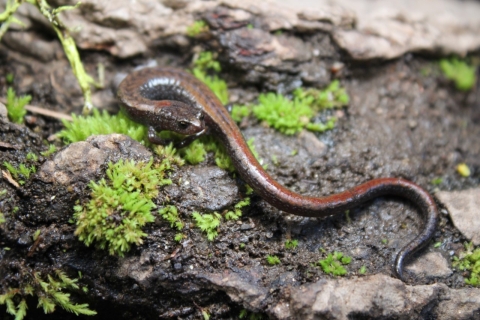Sacramento, Calif. - The U.S. Fish and Wildlife Service today announced the reopening of its October 2022 public comment period on the proposal to provide protections and designate critical habitat under the Endangered Species Act (ESA) for two slender salamanders living in California’s southern Sierra Nevada.
The Service invites public comment on a revision to the initial proposal that increases the proposed critical habitat for the Kern Canyon slender salamander and relictual slender salamander to 6,999 acres in Kern County, California, an increase of 2,263 acres from the initial proposal. The revision identifies areas essential to the conservation of the Kern Canyon slender salamander, which is proposed for listing as threatened, and the relictual slender salamander, which is proposed for listing as endangered under the ESA.
Through the public comment process on the initial proposal, the Service was made aware of new locations of the two salamander species outside the critical habitat boundaries initially proposed. The Service determined that the new location data constitute the best available science to use in designating critical habitat for the two species, and therefore has revised the initial proposal. The proposed critical habitat for the relictual slender salamander has been increased from 2,685 acres to 4,942 acres. The proposed critical habitat for the Kern Canyon slender salamander has increased from 2,051 acres to 2,057 acres.
The Service also received additional information on the habitat use of the Kern Canyon slender salamander. Species experts stated that the Kern Canyon slender salamander makes use of a broader range of habitats than was stated in the proposed rule. Based on this information, we updated our description of the habitat needs that are essential to the conservation of the Kern Canyon slender salamander to include open, rocky slopes adjacent to streams. All other aspects of the original proposal are unchanged in the updated proposal.
The Service is providing the public with an opportunity to review and comment on the new areas being considered for relictual slender salamander critical habitat, small changes to Kern Canyon slender salamander critical habitat and updates to the description of the habitat needs essential to the conservation of the Kern Canyon slender salamander.
“We appreciate the engagement the proposed rule received during the initial comment period,” said Michael Fris, field supervisor for the Sacramento Fish and Wildlife Office. “Because of this important process, we received valuable new information that helps us make the best scientifically informed decisions on the conservation of these two salamander species.”
Kern Canyon slender salamanders and relictual slender salamanders are found near water sources such as seeps, perennial springs and streams and are thought to rarely venture more than 50 feet from cover objects such as rocks and logs. The two salamander species are restricted to small areas that are almost completely within Sequoia National Forest, primarily near creeks and small watersheds that flow into the Kern River. The revised proposal is not expected to restrict recreational access on public lands.
The establishment of critical habitat will not prevent essential activities that reduce the risk of catastrophic wildfire and protect local communities, such as reducing forest fuels or maintaining fire breaks. Catastrophic, high-severity wildfire is a major threat to many species, including salamanders. The Service supports responsible land management activities that contribute to healthy forest ecosystems and reduce the risk of catastrophic wildfire. Through collaboration with federal, state and local government agencies, as well as private partners, these activities can continue while maintaining habitat components that the species require.
Today’s announcement comes as the ESA turns 50 years old in 2023. Throughout the year, the Department of the Interior is celebrating the importance of the ESA in preventing the extinction of imperiled species, promoting the recovery of wildlife and conserving the habitats upon which they depend. The ESA has been highly effective and credited with saving 99% of listed species from extinction. Thus far, more than 100 species of plants and animals have been delisted based on recovery or reclassified from endangered to threatened based on improved conservation status, and hundreds more species are stable or improving thanks to the collaborative actions of Tribes, federal agencies, state and local governments, conservation organizations and private citizens.
The revised proposed listing and critical habitat rule will publish in the Federal Register on November 21, 2023, and the public comment period will be open for 15 days. The Service will consider comments from all interested parties received by December 6, 2023. Comments previously submitted for the proposed rule do not need to be resubmitted. They will be fully considered in preparation of the final rule. The proposal and information on how to submit comments can be found on www.regulations.gov by searching under docket number FWS-R8-ES-2022-0081.
The U.S. Fish and Wildlife Service works with others to conserve, protect and enhance fish, wildlife, plants and their habitats for the continuing benefit of the American people. For more information, visit www.fws.gov and connect with us on social media:
Facebook, Instagram, X (formerly known as Twitter), LinkedIn, Flickr, and YouTube.





